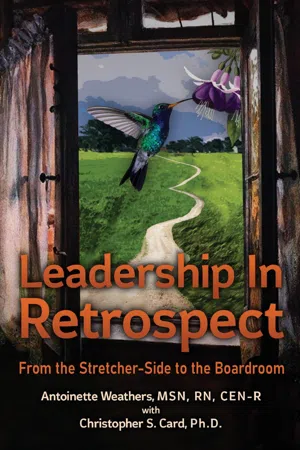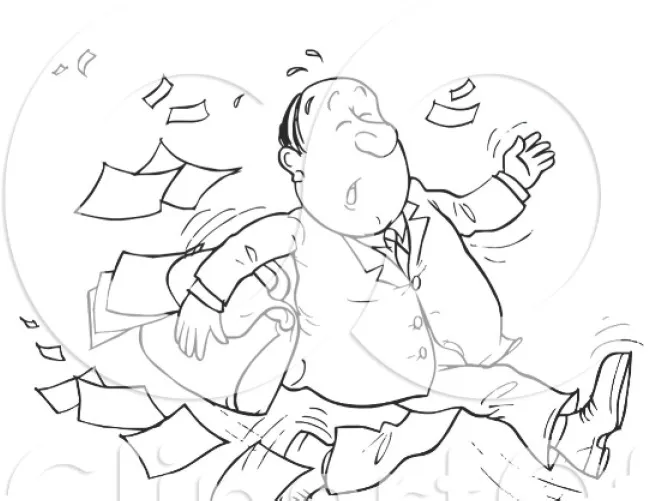![]() Part One
Part One![]()
Chapter One:
The Accidental Manager: Is This You?
Most of what you read about leadership sounds like common sense and appears easy to accomplish, but at least in my experience (if not yours), it’s not common practice. Sometimes leadership capabilities, such as motivating others, team building, and conflict resolution, are referred to as soft skills. That has always baffled me because management and leadership are very challenging! Just look around your organization. How many good leaders can you identify? There are very few people who can lead effectively if your organization is like most. I believe people are often unprepared as they begin their first assignments managing others. To complicate matters further, the people they are managing may have been their peers.
In a 2019 benchmark survey of the emergency, trauma, and transport nursing workforce, 38.5% of respondents cited a need for leadership/management training and explicitly reported a need for efficient, competent leaders (Schumaker et al., 2019). Perhaps this is because many people in management positions are what I refer to as accidental managers; they enter into their roles in a haphazard and unplanned manner. Worse, once promoted, people don’t always receive the support, training, and professional development needed to be successful.
The Peter Principle, first articulated by Laurence Peter, also adds to the problem of unqualified managers (Wikipedia Contributors, 2019). Typically, we begin our careers working in a specific area or performing particular functions in the organization. We become very proficient in our roles. Our technical skills, expertise, and performance create enough momentum that we are noticed and then promoted just above the competence level where we function best.
I feel comfortable stating this opinion because I was once an accidental manager and a byproduct of the Peter Principle. I stumbled into management. One day I was in an education role, then the next day, I was the nurse manager. The knowledge, skills, and abilities (KSAs) I possessed as an educator provided credibility in the high-tech world of healthcare, but I lacked the wisdom and experience for competence in management and leadership roles. Many mistake KSAs for wisdom. They are not the same things.
I quickly learned that clinical subject matter expertise (knowledge) does not make one wise. It’s the application of knowledge, skills, and abilities to everyday life that constitutes wisdom. What is the value and practicality of something if you know it but don’t know how to use it? I needed to polish skills such as delegation and communication, giving feedback, and having difficult conversations—the so-called soft skills. Having strong technical knowledge was not enough. Success in the new role required adaptability, agility, and motivation to reinvent my former self.
The lesson here is being good at one job does not guarantee one will easily transition and do well in another position. Organizations would be wise to reward based on performance and promote based on competencies required for the job. Promotions should be reserved for those who clearly can handle the next career step, not just for superior performance at the current level. Organizations must develop people, design succession planning strategies, and offer mentoring programs for bench strength. Leadership is a learned behavior. By proactively managing talent, the organization will have people in the pipeline ready to step up to the next level of responsibility.
Be prepared for the next opportunity! All of us have weaknesses. The strategy is to determine which ones can be improved, then get to work on those. Don’t let your leadership style develop accidentally.
Reflection
1.How did you get to be in the position you’re in? Are you an accidental manager?
2.Identify a minimum of two personal coaching needs. For example, are you comfortable with engaging in crucial conversations? Have you mastered the art and skill of public speaking?
3.Create a list of three prospective mentors. Reflect upon their attributes as you read the following sections.
![]()
Chapter Two:
A Conceptual Framework:
Leadership Domains of Success
A group of managers attended a leadership conference. The facilitator opened the session with a simple group exercise. Everyone was given a blank sheet of paper with instructions to take five minutes and list what needed to be changed in their organization. Here’s what some of the participants wrote:
“The CEO needs to get a backbone!”
“We need more staff and resources.”
“Replace the outdated office furniture.”
“We have too many meetings.”
“My co-workers lack accountability.”
Other responses were similar. Yet, no one in the audience wrote, “I need to change.”
Always look to yourself first. As leaders, we must role model the language of accountability. Ask the right questions. Begin inquiries with what and how, not why, when, or who. For example, “What can I do to develop myself?” and “How can I help?” Focus on “I,” not them.
What’s the Secret Sauce for Survival and Success?
I once read many newly placed executives fail within their first eighteen months. This fact resonated with me since I worked as a staff nurse in an emergency department notorious for rapid turnover among managers and directors. Unfortunately, there is no holy grail of leadership.
So, what are the drivers of achievement? How does one not only survive but also thrive and find joy throughout the journey? This section introduces a conceptual model for leadership survival and success in the twenty-first century, focusing on the three big Cs: Collaboration, Connections, and Communication, plus, of paramount importance: You!
I can almost hear the sighs. “Not a model!”
But don’t shy away. The framework is offered for visual learners (like me) to help organize our thinking and envision how complex relationships work together. Self-refinement is at the apex.
Domain One: Self-Refinement
Watch your thoughts, they become words;
Watch your words, they become actions;
Watch your actions, they become habits;
Watch your habits, they become character;
Watch your character, for it becomes your destiny.
(Goodreads, 2021, Frank Outlaw section)
Character is defined by Merriam-Webster (1991) as moral excellence, and it is a trait often attributed to leaders. As individuals, it’s essential to recognize the value of character and do what is needed to uphold personal and organizational values.
Core values are our fundamental beliefs or guiding principles that inform our decisions and dictate our behavior. Take a few moments to reflect upon your core values before continuing. What are your organization’s core values, and are they congruent with your personal ones?
It’s likely we share many of the same tenets.
Treating everyone with respect and dignity. A simple practice to adopt is to remember the names of people as well as something good about them, if possible. This includes becoming acquainted with the receptionists, environmental service and maintenance workforce, people who keep the software securely updated, deliver food trays, and others with whom you interact on a routine basis.
Being kind. Clothe yourself in compassion. Perform Acts of Kindness (Sandel, 2021). Self-compassion—simply giving the same kindness to ourselves that we give to others—is equally important.
Accepting people for who they are and peering beyond unfavorable qualities to see the good. Admittedly, I was not always forgiving of others. Amy, an insightful boss, helped me realize I had a “burn them at the stake” mentality. Her words, not mine. Please don’t judge me too harshly; I’ve already done that for you. Besides, my past sins carry their own punishments. A merciless, unforgiving temperament did not serve me well. Living life every day as if everything had to be perfect only made those around me miserable. Fortunately, I’ve learned we must be tolerant of mistakes. Don’t cling to a need for perfection in yourself or in others. It will drive people away. Perfection is attained only in the most fleeting of moments, and if you spend your life failing to attain it over and over again, you are going to end up with a life full of anguish and disappointment. Besides, have you noticed the only people who don’t make mistakes are those who never do anything?
Keeping commitments and promises builds trust. It’s one thing to talk about noble intentions and make pledges, but action is the best measure of fidelity. It can be challenging to keep track of promises you’ve made as new ones eclipse your time and attention. Find a simple method to track promises. If an adjustment becomes necessary in fulfilling a commitment, then communicate the modification and make a recommitment.
Steadfastly giving your best effort, even when you don’t want to. Steadfastly giving your best effort means consistently working toward what is important to you. No success is immediate, and no collapse is sudden. Both outcomes are the result of the momentum accrued through repetitive daily actions. Julius Erving, a former basketball superstar, once said, “Being a professional is doing things you love to do, (even) on the days you don’t feel like doing them” (Pink, 2009, p. 123). Put forth your best every day, and over time, your efforts yield a monumental positive impact.
Consistently taking a stand for what is right. Never backstab. It’s especially important to avoid idle gossip and always be loyal to those who are not present. In this way, you build the trust and respect of those present. An experienced trauma nurse knows ABCDE stands for Airway, Breathing, Circulation, Disability, Expose, and Environment (though not always in that sequence). However, to those who lack integrity, ABCDE can also stand for Accuse, Belittle, Criticize, Demoralize, and Expunge.
Remember, we judge ourselves based on our intentions, but others judge us based on our behavior. Therefore, we must exercise morality and employ congruency between our best intentions and our actions. Good leaders model a positive, optimistic attitude.
Attitude is the mindset or viewpoint that reflects our feelings toward the environment and other people. Simply put, it is our paradigm of the world, and it’s impacted by the circumstances we encounter. More importantly, however, attitude affects our response or how we react to those situations. A stimu...




